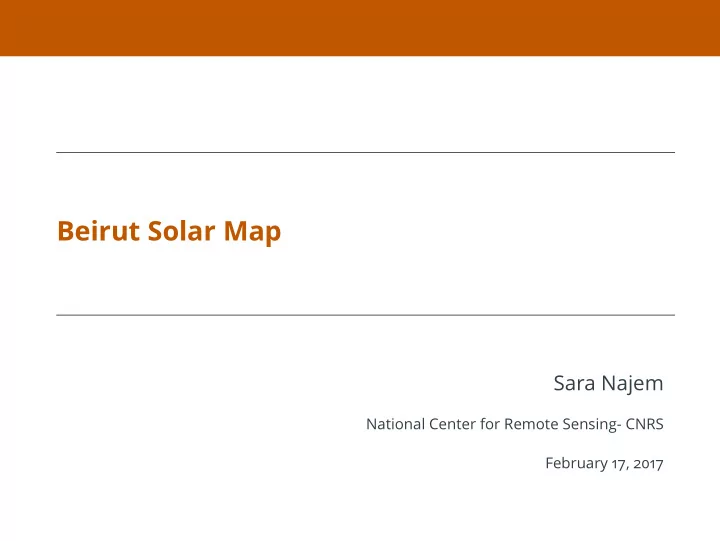

./figs/CockrellSchool Beirut Solar Map Sara Najem National Center for Remote Sensing- CNRS February 17, 2017
Outline ./figs/CockrellSchool Energy Demand/Supply in Lebanon Introduction Solar Radiation Algorithm City Scale Computation of Solar Irradiance Model Parameters and Assumptions Results Ongoing Work
Energy Demand/Supply in Lebanon ./figs/CockrellSchool ◮ ≈ 95 % of the energy needs are imported in the form of fuel. ◮ National production ≈ 5 % . ◮ Yearly growth in energy demand ≈ 3 − 7 % . salem2009 . salem2009 . chedid2002 .
Demand/Supply ./figs/CockrellSchool Electricty Demand and Supply (Million TWh) 15 10 5 Supply Volume Demand Volume 0 2008 2010 2012 2014 Year Year Figure : Evolution of the production and supply from 2008 to 2014
Demand/Supply ./figs/CockrellSchool ◮ The cost of electricity generation is around 23 cents/kWh ◮ Subscribers are charged 2.33 to 13.33 cents/kWh.
Energy Crisis ./figs/CockrellSchool With 3 hours of electricity rationing in Beirut and up to 8 elsewhere in the country we’re particularly interested in estimating the solar energy.
Energy Crisis ./figs/CockrellSchool Lebanon’s target for 2020: 12 percent of the energy produced from renewables (Copenhagen 2009). Lebanon also committed to a target of 15 % in its Intended Nationally Determined Contributions (INDC) submitted to the COP21 conference.
Solar Maps ./figs/CockrellSchool ◮ Solar maps are produced in major cities in the United States: Boston, Boulder, Cambridge, NY, San Francisco, Washington County, Well fl eet ◮ I nternationally: Lo Barnechea (Chile), Vitacura (Chile)
Solar Maps ./ fi gs/CockrellSchool ◮ Regionally, Beirut is the fi rst city to be mapped. I t is DSS application designed for National Center ofo Remote Sensing- CNRS as part of Local-Sats.
Solar Radiation ./ fi gs/CockrellSchool ◮ Direct radiation. ◮ Di ff use radiation. ◮ Re fl ected radiation.
Solar Radiation ./ fi gs/CockrellSchool
Basic De fi nitions ./ fi gs/CockrellSchool ◮ I rradiance is understood as instantaneous density of solar radiation incident on a given surface, typically expressed in W / m 2 . ◮ I rradiation is the sum of irradiance over a time period (e.g. 1 hour, day, month, year, etc.) expressed in J / m 2 .
I rradiation ./ fi gs/CockrellSchool I rradiation is then a ff ected by the sun ’ s position and cloud coverage and both of which are related to the location ’ s latitude.
Sun Path ./ fi gs/CockrellSchool The sun path changes on hourly and monthly scales; this has an e ff ect on the amount of irradiation a surface gets.
I llustrative Animation of the Solar Path ./ fi gs/CockrellSchool
City solar irradiation ./ fi gs/CockrellSchool For a city things become more complex as overshadowing of rooftops from neighboring buildings comes to play.
./ fi gs/CockrellSchool
Model Parameters and Assumptions ./ fi gs/CockrellSchool ◮ Flat roof-tops (L I DAR imagery or any 3 D data would improve the model ’ s predictions) ◮ With water tanks mounted on rooftops only a fraction of the rooftops is usable ≈ 30 %
Model Parameters and Assumptions ./ fi gs/CockrellSchool ◮ The fraction of di ff use radiation is taken to be 0 . 3 throughout the year. ◮ Panel e ffi ciency is 10 % sfeir80 .
./ fi gs/CockrellSchool
Comparison with Climatic Zoning ./ fi gs/CockrellSchool ◮ The climatic zoning Average Daily Global Horizontal I rradiation (ADGH I ) 4854 . 6 Wh / m 2 ◮ (ADGH I ) is ≈ 2000 Wh / m 2 ◮ Our computation is carried out in an urban setting taking into consideration overshadowing form neighboring buildings; this explains the discrepancy
Results ./ fi gs/CockrellSchool ◮ Generation Potential 394 GW/year assuming the whole rooftop area is usable ◮ 30 % usable rooftop yields 118 GW/year.
Results ./ fi gs/CockrellSchool ◮ Subsequently the savings could range from around $9.8 M to nearly $39.3 M ◮ CO2 emissions saving could range from 75,920 tCO2 to 322,660 tCO2
Ongoing Work ./figs/CockrellSchool ◮ The results are now being drafted as a policy paper in collaboration with the Director of the Energy Policy Program at Issam Fares Institute Dr. Ali Ahmad
Ongoing Work ./figs/CockrellSchool ◮ We are carrying out a study to model Beirut Energy hourly consumption ◮ Alaa Krayem is our PhD student; she is co-supervised by Dr. Haitham Zaraket of LU and Dr. Issam Lakkis of AUB.
Ongoing Work ./figs/CockrellSchool Figure : Boston ’ s Energy Model
Thank you! ./figs/CockrellSchool
Recommend
More recommend